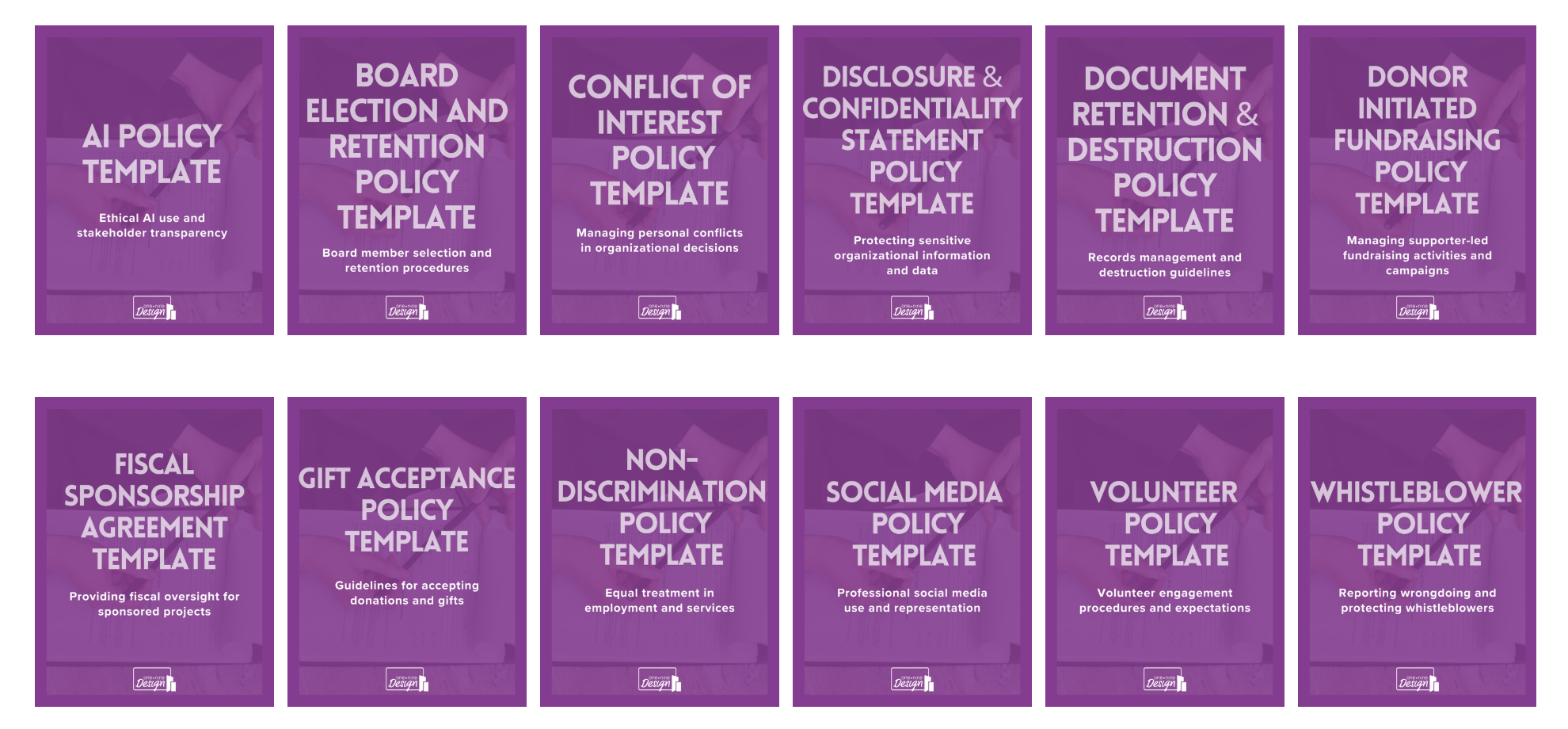Ten nonprofit policies and procedures every organization should have in their policies and procedures manual
Updated September 2025
Nonprofits are known for being accountable and transparent. They have to be, given that they are an exempt organization and public-facing entity with donor funds that must be managed responsibly.
But as it turns out, not all nonprofits operate with those high standards in mind. In fact, many fail to meet even basic standards of accountability and transparency. Perhaps most concerning of all is the fact that failing to follow legal guidelines can put nonprofits at risk of being shut down completely or having their tax-exempt status revoked by the IRS.
Fortunately, you don’t need to be a nonprofit law expert in order to stay compliant and avoid putting your organization at risk. Here are ten best practices that every nonprofit board should have as standard operating procedure (outside of your nonprofit bylaws) to ensure your organization remains above board and safe from unwanted scrutiny or issues in the future.
First, let’s answer the big questions:
What is a nonprofit polices and procedures manual?
A nonprofit policies and procedures manual is a document that outlines the policies and procedures that govern the operations and activities of a nonprofit organization. It serves as a reference guide for staff, volunteers, and board members and helps to ensure that the organization operates in a consistent and effective manner. The manual typically covers a wide range of topics, including financial management, personnel policies, fundraising, and program delivery. If you have all of the policies listed below and place them together in one cohesive document, you have a policies and procedures manual.
What are the benefits of having a nonprofit polices and procedures manual?
Having a well-defined policies and procedures manual can provide several benefits to a nonprofit organization, including:
Improved organization and efficiency: A clear set of policies and procedures helps to ensure that everyone involved in the organization is on the same page, reducing confusion and inefficiencies.
Better risk management: A comprehensive manual can help to minimize the risk of legal and financial problems by providing guidelines for activities that could expose the organization to liability.
Enhanced accountability: The manual serves as a reference for decision-making, ensuring that everyone involved in the organization is held accountable for their actions.
Better governance: By establishing clear policies and procedures, the manual helps to ensure that the board of directors is able to govern the organization effectively.
Overall, a nonprofit policies and procedures manual is an important tool for any nonprofit organization looking to operate effectively, efficiently, and responsibly.
So, let’s look at the policies that should be inside your policies and procedures manual:
What policies should a nonprofit have?
Gift acceptance policy
It's an Executive Director's dream - getting a phone call out of the blue from a donor who wants to give you a gift! But not so fast. What if those donations turn out to be a piece of real estate with strings attached? These unexpected phone calls with dicey scenarios about non-cash gifts can make even the most seasoned executive directors or board chairs panic. That's why it's really important to have a gift acceptance policy in place.
A good gift acceptance policy includes language to protect the organization against receiving gifts that may not be in the organization's best interest. This policy is established to ensure that each gift to the organization is structured to provide maximum benefits to the community, the donor, the organization, and the beneficiaries of the organization's charitable purposes.
If you're creating a gift acceptance policy or updating an existing one, ensure that it addresses both current and deferred gifts and non-cash gifts like real estate and securities. It should also name the responsible party for accepting gifts and procedures to reject gifts.
Want to take care of all your policies at one time with templates to use as a guide? Get twelve policy templates inside the Nonprofit Template Library, plus over 60 over templates and trainings to help you run your nonprofit organization more efficiently.
2. Social media policy
Almost everyone knows someone who has used their own social media platform to express controversial opinions about politics, local issues, or a number of other topics. However, what happens when that person is also an employee or board member of your organization and their opinions are interpreted to represent your organization?
Avoid this situation by having a social media policy that covers board members, general volunteers, and employees. Your social media policy should clearly state what is prohibited, if and how you plan to monitor social media activity connected to your non profit organization, how to report violations, and disciplinary procedures for employee behavior, as well as volunteer behavior.
3. Whistleblower policy
A Whistleblower Policy is used to prevent or detect and correct improper activities and encourage each organization director, officer, employee, and volunteer to report what he or she, in good faith, believes to be a material violation of law or policy or questionable accounting or auditing matter by the organization. These policies are also designed to protect the individual reporting such violations.
While it may seem unnecessary for the nonprofit sector, a whistleblower policy is vital for every organization. The policy should address who is responsible for reporting potential violations, the reporting procedures, how reports are handled, and how the individual reporter will be protected. The whistleblower policy should also be a part of your HR policies.
4. Non-discrimination policy
A non-discrimination policy is self-explanatory - it states explicitly that your organization will not discriminate in any way and applies to hiring, internal promotions, training, opportunities for advancement, and terminations. Add this one to your HR policies if you haven't already!
5. Document retention and destruction policy
A document retention and destruction policy isn't glamorous or fun, but every nonprofit organization should be expected to maintain complete, accurate, and high-quality records. If your nonprofit staff is making decisions on the fly about what to keep and what to toss, you could be exposing your organization to legal risk.
Your document retention and destruction policy should address the following:
- The employee or person responsible for overseeing document retention and destruction
- The on-site and off-site storage location for documents
- The security of cloud storage
- The method of document destruction
- A detailed schedule of document retention standards for your organization, including schedules for accounting, administration, human resources, and board governance.
6. Board election and retention policy
A board election and retention policy is a simple policy that states the criteria for both serving on the board of directors and remaining a board member. These policies can vary greatly depending on the size and maturity of the organization but often stipulate expected board performance, attendance policies, board giving requirements, compensation (or lack thereof), and board of directors conduct.
7. Conflict of interest for board members
It is inevitable that some board members will experience a conflict of interest in serving your organization. These conflicts do not have to mean that the board member can no longer serve but rather must disclose such conflicts in advance of any board meetings, discussions or voting.
For example, if you have a board member who works for a local financial institution where your nonprofit also happens to have a banking relationship, that conflict of interest must be disclosed. This does not (usually) mean that board member cannot serve - simply that the conflict must be made known to the entire board of directors.
Your conflict of interest policy should explicitly state the types of conflicts that may exist, the responsibility to report such conflicts, and how the organization will handle the conflict in the practice of conducting business.
8. Donor-initiated fundraising policy
Because there are numerous issues for tax purposes surrounding outside groups fundraising on behalf of your tax-exempt nonprofit organization, it is vital to have a policy statement to help guide those planning fundraising events and solicitations. A donor-initiated fundraising policy addresses several significant tax and accounting issues and the legal requirement to protect your charitable organization.
For example, activities must be conducted under the organization's observation and fiscal guidance to ensure that donors are entitled to the appropriate tax deductions, to protect the fundraising groups from unintended tax consequences to themselves, and to determine that the organization is not exposed to penalties from the Internal Revenue Service for failing to make required solicitation disclosures.
(And let's be real, also for the sanity of the nonprofit staff, along with ensuring the proposed activities support the mission statement of your organization!)
When creating your donor-initiated fundraising policy, the following items should be included:
- A statement that expresses clear expectations around the approval requirements of the proposed fundraising event or solicitation
- The responsibilities of both the fundraising group, the nonprofit organization, and its governing board
- How gifts will be logged, distributed, and acknowledged (along with staff member accountability)
- Specific reminders of events that do not qualify for tax exemption
- State charitable solicitation laws for your specific state
If you'd like a complete template for your own donor-initiated fundraising policy that includes a proposal and budget form, the entire Nonprofit Policy Bundle is included inside the Nonprofit Template Library.
9. Disclosure and Confidentiality Agreement
In the work of nonprofits, it's almost a given that board members or general-level volunteers will have access, at some point, to sensitive or confidential information. This may include donor records, grant information, financial records of collaborating partners, etc.
Since confidential and proprietary information is crucial to the operation of the foundation, and because your nonprofit organization in some instances has the obligation to protect such information, all those associated with the organization must agree not to use, publish, or disclose such information and to preserve the restricted nature of this information except to the extent that it becomes publicly available, or is otherwise lawfully obtained.
This agreement should be presented to the board member upon their initial onboarding.
10. AI Policy
As artificial intelligence tools become increasingly accessible and affordable, nonprofits are rapidly adopting these technologies to enhance their operations, from drafting grant proposals to creating social media content. However, this adoption often happens without clear guidelines, creating significant risks around data privacy, accuracy, and stakeholder trust. Nonprofits handle sensitive donor information, client data, and confidential plans that could be compromised if AI tools aren't used properly.
Additionally, the public expects transparency from charitable organizations, making it crucial to have clear policies about when and how AI is being used in organizational communications and decision-making.
Our AI Use and Disclosure Policy template provides nonprofits with a comprehensive framework that balances innovation with responsibility. The policy covers essential areas including data classification and protection protocols, quality control standards with mandatory human oversight, clear disclosure requirements for AI-assisted content, and staff training procedures. It also addresses the unique challenges nonprofits face, such as maintaining donor trust, ensuring cultural sensitivity in program materials, and complying with charitable solicitation regulations. The template includes practical tools like approval processes for new AI platforms, tiered review procedures based on content risk, and accountability measures that protect both the organization and its stakeholders while allowing staff to leverage AI's benefits effectively.
Our AI Policy Template covers all the bases and prepares you to customize the policy to fit your organization’s specific needs. There are twelve policies included in our Policy Bundle, inside the Nonprofit Template Library.
Common questions about nonprofit policies and procedures
-
Nonprofit policies provide a framework for consistent and ethical decision-making. They protect the organization from legal and financial risks, ensure compliance with regulations, and promote transparency among staff, volunteers, and donors. For more guidance, check out the National Council of Nonprofits.
-
The policies your nonprofit is required to have vary by state and federal law. At a minimum, most nonprofits should have:
A conflict of interest policy
Whistleblower protections
Document retention and destruction policies
For more information, visit IRS Compliance Guidelines for 501(c)(3) Organizations.
-
Policies should be reviewed at least annually to ensure they remain compliant with legal standards and reflect the organization's current operations. Updates might be needed sooner if there are changes in laws or significant shifts in the nonprofit’s programs or leadership.
-
Yes! Templates are an excellent starting point, but they should be customized to reflect the specific needs of your organization. For example, a gift acceptance policy for a large nonprofit may differ from one for a smaller local charity. Check out the Nonprofit Template Library for our policies bundle!
-
Training and regular communication are key. Provide staff and volunteers with clear, accessible copies of all policies. Host annual training sessions and incorporate policies into onboarding materials.
Final Thoughts on Nonprofit Policies and Procedures
These foundational policies are far from flashy or fun to create or update, but they can be significant to the health and maturity of your organization and serve to protect your organization in unexpected moments. It's best to build time in your schedule at least bi-annually to review your policies and update them accordingly.
Or, if you've never created these nine policies, it's time to begin. If you're looking for a place to start (and like a good shortcut!), you can grab the Nonprofit Policy Bundle in the Nonprofit Template Library -- twelve policies are already created and ready for your customization. Just plug in your organization name, and specifics where you'd like to make adjustments, and schedule a time to review the document with your board, tax advisor, or attorney.
Let me know below what policies you'd add to the list!
You might find these related posts helpful…


















